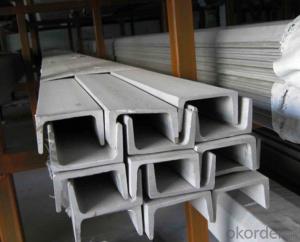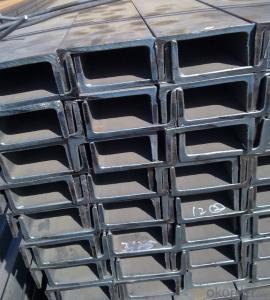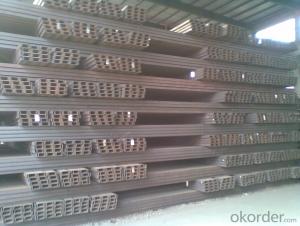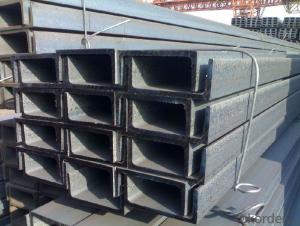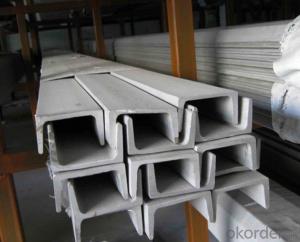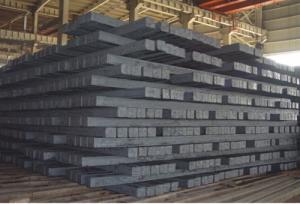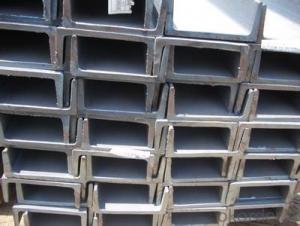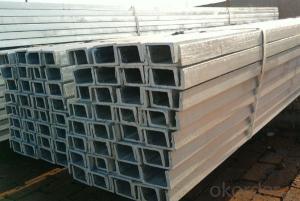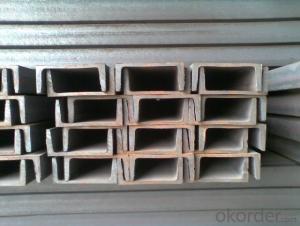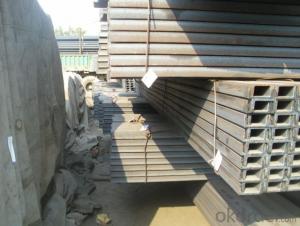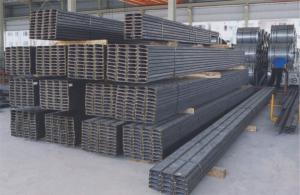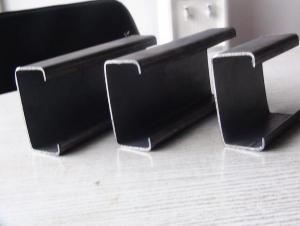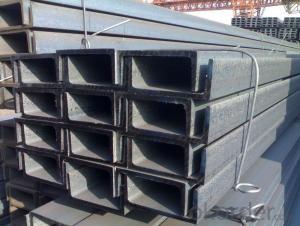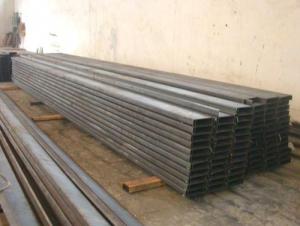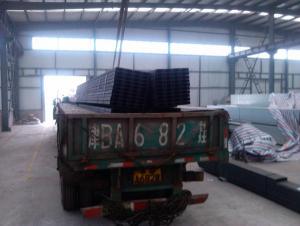GB U Channel 50MM-300MM High Quality Hot Rolled
- Loading Port:
- Tianjin
- Payment Terms:
- TT or LC
- Min Order Qty:
- 25 m.t.
- Supply Capability:
- 20000 m.t./month
OKorder Service Pledge
OKorder Financial Service
You Might Also Like
Product Description:
OKorder is offering high quality Hot Rolled Steel I-Beams at great prices with worldwide shipping. Our supplier is a world-class manufacturer of steel, with our products utilized the world over. OKorder annually supplies products to European, North American and Asian markets. We provide quotations within 24 hours of receiving an inquiry and guarantee competitive prices.
Product Applications:
According to the needs of different structures, Angle can compose to different force support component, and also can be the connections between components. It is widely used in various building structures and engineering structures such as roof beams, bridges, transmission towers, hoisting machinery and transport machinery, ships, industrial furnaces, reaction tower, container frame and warehouse etc
Product Advantages:
OKorder's Steel I-Beams are durable, strong, and resist corrosion.
Main Product Features:
· Premium quality
· Prompt delivery & seaworthy packing (30 days after receiving deposit)
· Corrosion resistance
· Can be recycled and reused
· Mill test certification
· Professional Service
· Competitive pricing
Product Specifications:
Manufacture: Hot rolled
Grade: Q195 – 235
Certificates: ISO, SGS, BV, CIQ
Length: 6m – 12m, as per customer request
Packaging: Export packing, nude packing, bundled
Sizes: 25mm-250mm | ||
a*t | ||
25*2.5-4.0 | 70*6.0-9.0 | 130*9.0-15 |
30*2.5-6.6 | 75*6.0-9.0 | 140*10-14 |
36*3.0-5.0 | 80*5.0-10 | 150*10-20 |
38*2.3-6.0 | 90*7.0-10 | 160*10-16 |
40*3.0-5.0 | 100*6.0-12 | 175*12-15 |
45*4.0-6.0 | 110*8.0-10 | 180*12-18 |
50*4.0-6.0 | 120*6.0-15 | 200*14-25 |
60*4.0-8.0 | 125*8.0-14 | 250*25 |
FAQ:
Q1: How do we guarantee the quality of our products?
A1: We have established an advanced quality management system which conducts strict quality tests at every step, from raw materials to the final product. At the same time, we provide extensive follow-up service assurances as required.
Q2: How soon can we receive the product after purchase?
A2: Within three days of placing an order, we will begin production. The specific shipping date is dependent upon international and government factors, but is typically 7 to 10 workdays.
Q3: What makes stainless steel stainless?
A3: Stainless steel must contain at least 10.5 % chromium. It is this element that reacts with the oxygen in the air to form a complex chrome-oxide surface layer that is invisible but strong enough to prevent further oxygen from "staining" (rusting) the surface. Higher levels of chromium and the addition of other alloying elements such as nickel and molybdenum enhance this surface layer and improve the corrosion resistance of the stainless material.
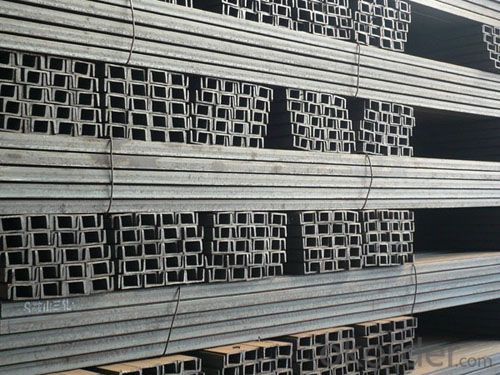
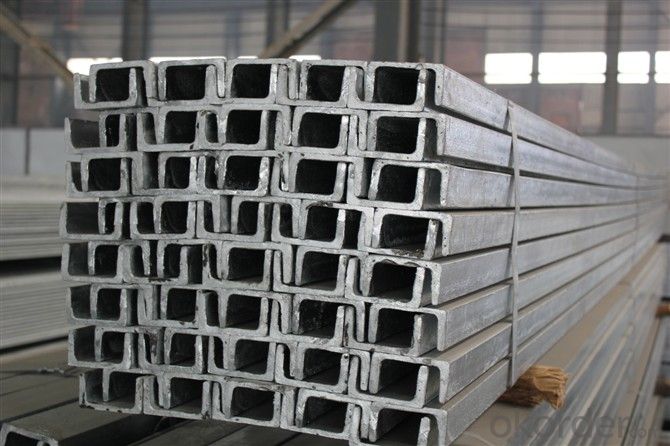

- Q: What are the different methods of protecting steel channels from corrosion?
- There are several methods available for protecting steel channels from corrosion. These methods can be categorized into surface coatings, cathodic protection, and alloying. Surface coatings are one of the most common methods used to protect steel channels from corrosion. These coatings create a barrier between the steel and the corrosive environment, preventing direct contact and thus inhibiting corrosion. Some commonly used surface coatings include paint, epoxy, zinc-rich coatings, and galvanizing. Cathodic protection is another effective method for protecting steel channels from corrosion. It involves introducing a sacrificial anode, typically made of zinc or magnesium, which is more reactive than the steel. This sacrificial anode corrodes instead of the steel, effectively protecting it from corrosion. Cathodic protection can be achieved through galvanic systems or impressed current systems, depending on the specific application. Alloying is a method of protecting steel channels by modifying their composition. By adding elements such as chromium, nickel, or molybdenum, the steel's corrosion resistance can be significantly enhanced. Stainless steel, for example, is an alloy that contains a high amount of chromium, which forms a protective oxide layer on its surface, making it highly resistant to corrosion. It is important to note that the selection of the appropriate method for protecting steel channels from corrosion depends on various factors such as the corrosive environment, the intended use of the channels, and the budget constraints. Consulting with corrosion experts and engineers is crucial in order to determine the most suitable method for each specific application.
- Q: Steel GB channel and non GB there is no difference?
- From the price can be found at a glance, the cost is really reduced; finally, we recommend that you do not buy non - standard channel steel.
- Q: Are steel channels available in non-standard lengths?
- Non-standard lengths of steel channels are indeed obtainable. Although the usual lengths for steel channels usually span 20 feet or 6 meters, there exist manufacturers and suppliers who extend custom cutting services to cater to customers' specific requirements. Such provision grants construction and fabrication projects greater flexibility, accommodating the demand for precise measurements and tailored lengths. Furthermore, non-standard lengths offer the advantage of minimizing waste and optimizing material usage, ultimately resulting in cost savings. To explore the possibilities and capabilities of steel channel suppliers or manufacturers regarding non-standard lengths, it is essential to consult them directly.
- Q: What are the fire resistance properties of steel channels?
- Steel channels have excellent fire resistance properties due to the inherent characteristics of steel. Steel has a high melting point, which means it can withstand high temperatures without losing its structural integrity. Additionally, steel channels do not contribute to the spread of fire as they are non-combustible. This makes steel channels a reliable choice for applications where fire resistance is a priority, such as in building construction and fire-rated assemblies.
- Q: Can steel channels be used for handrail supports?
- Yes, steel channels can be used for handrail supports. Steel channels provide strength and durability, making them suitable for supporting handrails and ensuring safety.
- Q: Can steel channels be used for racking and shelving systems?
- Yes, steel channels can be used for racking and shelving systems. Steel channels are strong and durable, making them ideal for supporting heavy loads. They can be easily installed and provide stability and structural integrity to the racking and shelving units. Additionally, steel channels are resistant to corrosion, ensuring a longer lifespan for the racking and shelving systems.
- Q: What are the different shapes of steel channels available?
- Some of the different shapes of steel channels available include C channels, U channels, and MC channels.
- Q: Are steel channels suitable for gymnasium structures?
- Yes, steel channels are suitable for gymnasium structures. Steel channels are commonly used in construction due to their durability, strength, and versatility. They are ideal for gymnasium structures as they can support heavy loads and provide stability. Additionally, steel channels can be easily fabricated and installed, making them a cost-effective choice for gymnasium construction. Moreover, steel channels have excellent resistance to fire, corrosion, and pests, ensuring the longevity of the gymnasium structure. Overall, steel channels are a reliable and practical option for constructing gymnasiums.
- Q: What are the design considerations when using steel channels?
- When using steel channels, there are several design considerations to take into account. Firstly, it is important to consider the load-bearing capacity of the channels, ensuring they can adequately support the intended weight and forces. Additionally, the dimensions and shape of the channels should be carefully chosen to align with the structural requirements and desired aesthetic. The material properties of steel, such as its strength, durability, and resistance to corrosion, should also be considered to ensure long-term performance. Lastly, factors like fabrication and installation methods, as well as cost considerations, should be taken into account during the design process.
- Q: What are the different types of steel channel sections?
- There are several different types of steel channel sections, including C channels, U channels, and Z channels. C channels have a C-shaped cross-section and are commonly used for structural applications such as framing and supports. U channels have a U-shaped cross-section and are often used as edging or trim on metal sheets or as structural components in construction. Z channels have a Z-shaped cross-section and are typically used for framing and support applications where additional strength is required.
Send your message to us
GB U Channel 50MM-300MM High Quality Hot Rolled
- Loading Port:
- Tianjin
- Payment Terms:
- TT or LC
- Min Order Qty:
- 25 m.t.
- Supply Capability:
- 20000 m.t./month
OKorder Service Pledge
OKorder Financial Service
Similar products
Hot products
Hot Searches
Related keywords
